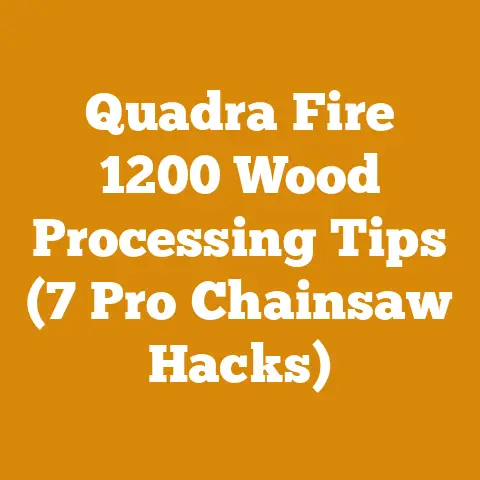36in Stihl Chainsaw Size Guide (Pro Tips for Efficient Felling)
The Beast in the Woods: A 36-Inch Stihl Chainsaw Size Guide (Pro Tips for Efficient Felling) & Mastering Firewood Costs
Introduction: The Overwhelmed Woodworker
How many times have you stood at the edge of a property line, staring at a towering oak, wondering if your chainsaw is up to the task? I know I have. In fact, I remember one particularly frustrating afternoon trying to fell a seasoned maple with a saw that was clearly outmatched. The chain kept binding, the engine strained, and I spent more time wrestling with the saw than actually cutting. The truth is, choosing the right chainsaw – especially when you’re dealing with serious timber – can be the difference between a productive day and a costly, exhausting failure. In this article, I’m going to focus on the 36-inch Stihl chainsaw. What size trees it can tackle, the pro tips I’ve learned over the years for efficient felling, and, crucially, how to factor in the real costs of using such a powerful tool. We’ll dive into everything from fuel consumption to chain sharpening, and even explore some budget-friendly alternatives for smaller jobs.
Why a 36-Inch Chainsaw? Understanding the Need for Power
Let’s be clear: a 36-inch chainsaw isn’t your average homeowner’s tool. It’s designed for tackling large diameter trees, typically those exceeding 24 inches in diameter. These chainsaws are favored by professional loggers, arborists, and anyone who regularly deals with mature hardwoods.
- Felling Large Trees: The primary purpose of a 36-inch bar is to fell large trees efficiently and safely. The longer bar allows you to cut through the trunk in a single pass, reducing the risk of pinching and kickback.
- Bucking Large Logs: Once a tree is on the ground, a 36-inch saw makes quick work of bucking it into manageable lengths for firewood or milling.
- Milling: While not ideal for dedicated milling operations, a 36-inch chainsaw can be used with an Alaskan mill attachment to slab logs into lumber.
Choosing the Right 36-Inch Stihl: Models and Considerations
Stihl offers a range of 36-inch chainsaws, each with slightly different features and performance characteristics. Here are a few popular models:
- Stihl MS 661 C-M: This is a professional-grade saw known for its power and durability. It features Stihl’s M-Tronic engine management system, which automatically adjusts the engine settings for optimal performance.
- Stihl MS 881: Billed as Stihl’s most powerful production chainsaw, this behemoth is designed for the most demanding felling and milling applications. It is the go-to saw for giant trees.
When choosing a 36-inch Stihl, consider the following:
- Engine Power: Look for a chainsaw with sufficient horsepower (HP) or cubic centimeters (cc) to handle the type of wood you’ll be cutting. Hardwoods like oak and maple require more power than softwoods like pine and fir. The MS 661 C-M, for example, boasts around 7.37 HP, while the MS 881 delivers a staggering 8.6 HP.
- Weight: A 36-inch chainsaw is inherently heavy. Consider your physical strength and stamina when choosing a model. The MS 661 C-M weighs around 16.3 pounds (without fuel and bar), while the MS 881 tips the scales at a hefty 21.4 pounds.
- Features: Look for features like anti-vibration systems, chain brakes, and easy-start technology to improve comfort and safety.
- Budget: 36-inch Stihl chainsaws are a significant investment. Be prepared to spend upwards of \$1,500 for a professional-grade model. The MS 881 can easily exceed \$2,000. Used models can be found, but inspect them thoroughly.
Pro Tips for Efficient Felling with a 36-Inch Chainsaw
Felling large trees is a dangerous task, and it’s crucial to follow proper safety procedures and techniques. Here are some pro tips I’ve learned over the years:
- Assess the Tree: Before making any cuts, carefully assess the tree for lean, wind direction, and any potential hazards like dead branches or power lines.
- Plan Your Escape Route: Always have a clear escape route planned in case the tree falls unexpectedly.
- Make a Proper Notch: The notch determines the direction of the fall. A properly made notch should be about one-third of the tree’s diameter.
- Use a Felling Wedge: A felling wedge can help to direct the fall of the tree and prevent the saw from pinching.
- Communicate with Your Team: If you’re working with a team, clear communication is essential. Use hand signals to communicate your intentions and ensure everyone is aware of potential hazards.
- Maintain Your Saw: A sharp chain is essential for efficient and safe felling. Sharpen your chain regularly and inspect your saw for any signs of damage.
The Real Cost of Running a 36-Inch Chainsaw: Beyond the Purchase Price
Okay, let’s get down to brass tacks. Buying a 36-inch Stihl is just the starting point. The real cost lies in the ongoing maintenance, fuel, and consumables. I’ve seen many people underestimate these costs, leading to budget overruns and frustration.
1. Fuel Costs: A Hungry Beast
A 36-inch chainsaw, especially when running at full throttle, consumes a significant amount of fuel. Let’s break down the estimated fuel consumption:
- Average Fuel Consumption: A 36-inch Stihl can consume anywhere from 0.2 to 0.4 gallons of fuel per hour, depending on the load and engine size. Let’s take an average of 0.3 gallons per hour.
- Fuel Price: Assuming a fuel price of \$4.00 per gallon (this fluctuates, so check your local prices!), that’s \$1.20 per hour just in fuel.
- Annual Usage: If you use your saw for 100 hours per year, that’s \$120 in fuel costs. For a professional logger using it 40 hours a week, that jumps to \$9,600 per year!
Data Point: According to the U.S. Energy Information Administration (EIA), the average retail price of gasoline in the U.S. in January 2024 was around \$3.15 per gallon. However, fuel prices can vary significantly depending on location and grade. Premium fuel is often recommended for high-performance chainsaws, adding to the cost.
2. Chain and Bar Oil: Keeping Things Running Smoothly
Chain and bar oil are essential for lubricating the chain and bar, reducing friction and wear.
- Oil Consumption: A 36-inch chainsaw will typically consume around 1 gallon of bar oil for every 10-20 gallons of fuel. Let’s assume 1 gallon of oil for every 15 gallons of fuel.
- Oil Price: A gallon of high-quality bar oil costs around \$15-25. Let’s take an average of \$20 per gallon.
- Annual Usage: If you use 100 gallons of fuel per year, you’ll need about 6.67 gallons of bar oil, costing you around \$133.40.
3. Chain Sharpening: A Sharp Chain is a Safe Chain
A dull chain is not only inefficient but also dangerous. You have two options: sharpen the chain yourself or take it to a professional.
- DIY Sharpening: Investing in a chainsaw sharpening kit (around \$50-100) will allow you to sharpen your chain yourself. However, this requires skill and practice. The cost of files and guides will need to be factored in as well. I spend roughly \$20 a year on files.
- Professional Sharpening: Taking your chain to a professional sharpener will cost around \$10-20 per sharpening.
- Frequency: Depending on the type of wood you’re cutting, you may need to sharpen your chain every few hours of use. Let’s assume you need to sharpen your chain every 5 hours.
Cost Calculation: If you use your saw for 100 hours per year and sharpen the chain every 5 hours, you’ll need to sharpen it 20 times. At \$15 per sharpening, that’s \$300 per year.
4. Chain Replacement: Wear and Tear
Chains eventually wear out and need to be replaced. The lifespan of a chain depends on the type of wood you’re cutting, the quality of the chain, and how well you maintain it.
- Chain Price: A high-quality 36-inch chainsaw chain costs around \$50-80. Let’s take an average of \$65.
- Replacement Frequency: A chain might last for 50-100 hours of use, depending on conditions. Let’s assume 75 hours.
- Annual Usage: If you use your saw for 100 hours per year, you’ll need to replace the chain about 1.33 times, costing you around \$86.45.
5. Bar Replacement: The Foundation of Your Cut
The chainsaw bar also wears out over time and needs to be replaced.
- Bar Price: A high-quality 36-inch chainsaw bar costs around \$100-150. Let’s take an average of \$125.
- Replacement Frequency: A bar might last for 200-400 hours of use. Let’s assume 300 hours.
- Annual Usage: If you use your saw for 100 hours per year, you’ll need to replace the bar about 0.33 times, costing you around \$41.25.
6. Maintenance and Repairs: The Inevitable Expenses
Like any piece of machinery, a chainsaw requires regular maintenance and occasional repairs.
- Air Filter: Clean or replace the air filter regularly to ensure proper engine performance. Air filters cost around \$5-10.
- Spark Plug: Replace the spark plug annually. Spark plugs cost around \$5-10.
- Carburetor Adjustment: Carburetor adjustments may be necessary to ensure proper fuel-air mixture. This can be done yourself or by a professional.
- Repairs: Occasional repairs, such as replacing the starter cord or fuel lines, are inevitable.
Estimated Annual Maintenance and Repair Costs: Let’s estimate this at around \$50-100 per year.
7. Safety Gear: Protecting Yourself
Safety gear is essential when operating a chainsaw.
- Helmet with Face Shield and Ear Protection: A good helmet costs around \$50-100.
- Chainsaw Chaps: Chainsaw chaps protect your legs from accidental cuts. They cost around \$100-200.
- Gloves: Heavy-duty gloves protect your hands. They cost around \$20-40.
- Steel-Toed Boots: Steel-toed boots protect your feet. They cost around \$100-200.
While you don’t need to replace these items every year, they will eventually wear out and need to be replaced. Let’s allocate \$50 per year for safety gear replacement.
8. Storage and Transportation: Protecting Your Investment
Storing and transporting your chainsaw properly is essential to protect it from damage.
- Chainsaw Case: A chainsaw case protects your saw from dust, dirt, and damage during storage and transportation. Cases cost around \$50-100.
- Fuel Can: A high-quality fuel can is essential for storing and transporting fuel safely. Fuel cans cost around \$20-40.
- Transportation: If you need to transport your chainsaw to a remote location, you may need a truck or trailer.
Let’s allocate \$25 per year for storage and transportation costs.
Total Annual Cost of Running a 36-Inch Chainsaw (Estimated)
Let’s add up all the estimated costs:
- Fuel: \$120
- Bar Oil: \$133.40
- Chain Sharpening: \$300 (or \$20 for DIY)
- Chain Replacement: \$86.45
- Bar Replacement: \$41.25
- Maintenance and Repairs: \$75
- Safety Gear: \$50
- Storage and Transportation: \$25
Total: \$831.10 per year (or \$551.10 if you sharpen your own chains)
Data Point: A study by the University of Maine found that the average cost of owning and operating a chainsaw for firewood harvesting is around \$500 per year. However, this study included smaller chainsaws and did not account for the higher fuel consumption and maintenance costs of a 36-inch model.
Variable Factors Affecting Costs: The Devil is in the Details
It’s important to remember that these are just estimates. The actual cost of running a 36-inch chainsaw can vary significantly depending on several factors:
- Type of Wood: Hardwoods like oak and maple require more power and will wear out your chain and bar faster than softwoods like pine and fir.
- Cutting Conditions: Cutting dirty or sandy wood will dull your chain faster and increase wear and tear on your saw.
- Maintenance Habits: Regular maintenance, such as cleaning the air filter and sharpening the chain, can significantly extend the life of your saw and reduce repair costs.
- Fuel Prices: Fuel prices can fluctuate significantly, impacting your fuel costs.
- Your Skill Level: Inexperience can lead to mistakes that damage your saw or require professional repairs.
Cost Optimization Strategies: Saving Money Without Sacrificing Performance
While running a 36-inch chainsaw can be expensive, there are several ways to optimize your costs:
- Buy Fuel in Bulk: Buying fuel in bulk can save you money on fuel costs.
- Sharpen Your Own Chains: Learning to sharpen your own chains can save you money on professional sharpening fees.
- Maintain Your Saw Regularly: Regular maintenance can extend the life of your saw and reduce repair costs.
- Use High-Quality Fuel and Oil: Using high-quality fuel and oil can improve engine performance and reduce wear and tear.
- Consider an Electric Chainsaw for Smaller Jobs: For smaller jobs, consider using an electric chainsaw. Electric chainsaws are less expensive to operate and require less maintenance. They are better for the environment too.
- Rent a Chainsaw: If you only need a 36-inch chainsaw for occasional use, consider renting one instead of buying one. Rental rates typically range from \$50-100 per day.
Data Point: According to a report by the National Renewable Energy Laboratory (NREL), the cost of electricity from renewable sources like solar and wind has decreased significantly in recent years, making electric chainsaws an increasingly cost-effective option for some applications.
Budgeting for Firewood Preparation: A Case Study
Let’s say you’re planning to harvest 10 cords of firewood using a 36-inch Stihl chainsaw. Here’s a sample budget:
- Timber Purchase (if applicable): \$0-500 (depending on whether you own the land or need to purchase timber rights)
- Fuel: \$120 (assuming 100 hours of chainsaw use)
- Bar Oil: \$133.40
- Chain Sharpening: \$300 (or \$20 if DIY)
- Chain Replacement: \$86.45
- Bar Replacement: \$41.25
- Maintenance and Repairs: \$75
- Safety Gear: \$50
- Equipment Rental (wood splitter, etc.): \$200-500 (depending on rental rates and duration)
- Labor (if hiring help): \$500-1000 (depending on hourly rates and number of workers)
- Transportation: \$100 (truck rental, fuel)
Total Estimated Cost: \$1,605.10 – \$3,205.10 (or \$1,325.10 – \$2,925.10 if you sharpen your own chains and don’t need to purchase timber)
Cost Per Cord: \$160.51 – \$320.51 (or \$132.51 – \$292.51 if you sharpen your own chains and don’t need to purchase timber)
Industry Benchmarks: According to the U.S. Department of Energy, the average price of firewood ranges from \$150 to \$400 per cord, depending on location, wood type, and seller.
Calculating Wood Volume: Board Feet vs. Cords
Understanding how to calculate wood volume is crucial for budgeting and pricing firewood or lumber.
- Board Foot: A board foot is a unit of measurement for lumber, equal to 1 inch thick, 12 inches wide, and 12 inches long.
- Cord: A cord is a unit of measurement for firewood, equal to a stack of wood 4 feet high, 4 feet wide, and 8 feet long.
- Converting Board Feet to Cords: The conversion factor varies depending on the type of wood and how tightly it is stacked. As a general rule, 500 board feet of lumber is roughly equivalent to 1 cord of firewood.
Formula for Estimating Board Feet in a Log:
(Diameter in inches)² x (Length in feet) / 144
Example: A log with a diameter of 12 inches and a length of 10 feet would contain approximately 10 board feet.
(12² x 10) / 144 = 10
Estimating Drying Time: The Importance of Seasoning
Seasoning firewood is essential for efficient burning and reducing creosote buildup in your chimney.
- Moisture Content: Freshly cut wood can have a moisture content of 50% or more. Seasoned firewood should have a moisture content of 20% or less.
- Drying Time: The drying time depends on the type of wood, the climate, and how the wood is stacked. As a general rule, hardwoods like oak and maple take 6-12 months to season, while softwoods like pine and fir take 3-6 months.
- Stacking: Stacking firewood in a single row, off the ground, and under a cover will promote faster drying.
Formula for Estimating Drying Time:
Drying Time (months) = (Initial Moisture Content – Target Moisture Content) / Drying Rate
The drying rate varies depending on the climate and wood type.
Challenges Faced by Small-Scale Loggers and Firewood Suppliers: A Global Perspective
Small-scale loggers and firewood suppliers face numerous challenges, including:
- Fluctuating Timber Prices: Timber prices can fluctuate significantly, making it difficult to predict profitability.
- Equipment Costs: Chainsaws, wood splitters, and other equipment are expensive to purchase and maintain.
- Labor Costs: Hiring labor can be expensive, especially in areas with high minimum wages.
- Permitting and Regulations: Obtaining permits and complying with regulations can be time-consuming and costly.
- Competition: The firewood market can be competitive, especially in areas with a large number of suppliers.
Idioms and Expressions Relatable to a Global Audience:
- “Cut to the chase” (get to the point)
- “Barking up the wrong tree” (pursuing the wrong course of action)
- “A dime a dozen” (common and inexpensive)
- “The whole nine yards” (everything possible)
- “Burning the candle at both ends” (working excessively hard)
Actionable Takeaways and Next Steps:
- Assess Your Needs: Determine the size and type of trees you’ll be cutting to choose the right chainsaw.
- Factor in All Costs: Don’t just focus on the purchase price of the chainsaw. Consider fuel, oil, maintenance, and safety gear.
- Create a Budget: Develop a detailed budget for your wood processing or firewood preparation project.
- Optimize Your Costs: Implement cost-saving strategies like buying fuel in bulk and sharpening your own chains.
- Prioritize Safety: Always wear appropriate safety gear and follow proper felling techniques.
Conclusion: Mastering the Chainsaw and the Costs
Investing in a 36-inch Stihl chainsaw is a significant decision, but with the right knowledge and planning, you can master both the tool and the associated costs. By understanding the true cost of ownership, implementing cost-saving strategies, and prioritizing safety, you can efficiently and safely tackle large-scale wood processing projects. Remember, a well-maintained chainsaw and a well-managed budget are essential for success in the woods. So, sharpen your chain, fuel up your saw, and get ready to conquer those towering trees!
Disclaimer: The cost data and estimates provided in this article are for informational purposes only and may vary depending on your specific circumstances. Always consult with local professionals for accurate pricing and regulatory information.






